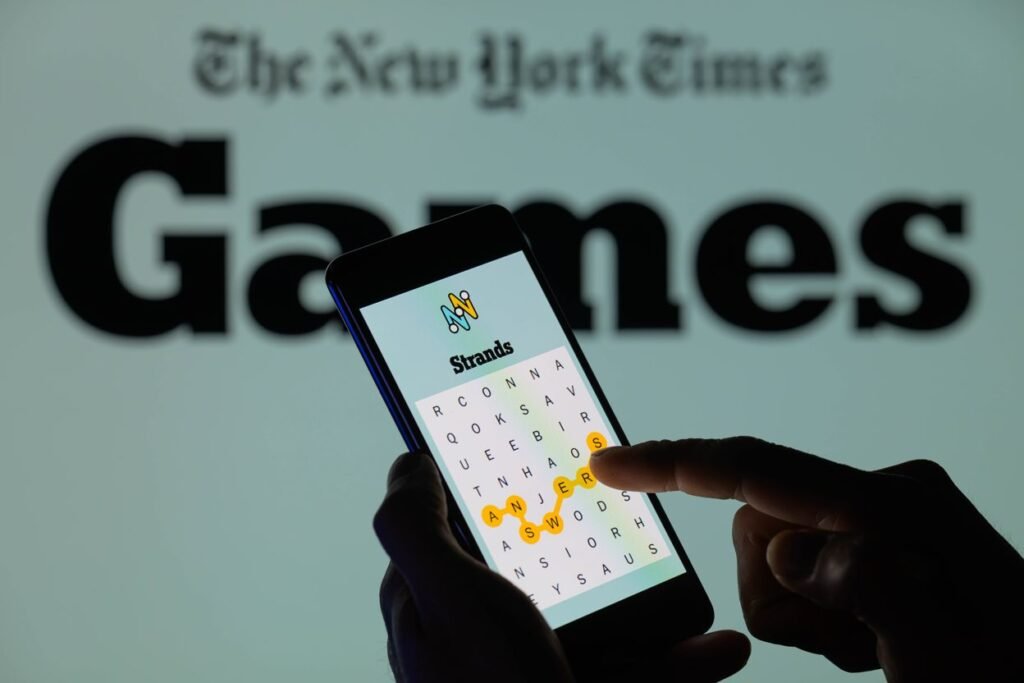puzzle has long been a favorite pastime for many puzzle enthusiasts, offering a daily challenge that combines wit, knowledge, and a bit of luck. Among its various features, the NYT Strands puzzle stands out as a unique element, often leaving players pondering over hints and solutions. In this blog post, we will delve into what the NYT Strands are, provide hints and strategies for solving them, and offer answers to some recent puzzles to enhance your crossword-solving skills.
What Are NYT Strands?
The NYT Strands is a specialized segment of the crossword puzzle that often consists of a series of interconnected clues or themes. Unlike traditional crossword puzzles, which typically have a straightforward grid, the Strands puzzles are designed to be more intricate, requiring solvers to make connections across different clues. These puzzles may include multiple themes or shared answers that intersect in unexpected ways, creating a rich tapestry of wordplay and lateral thinking.
Understanding the Structure
Before we dive into hints and answers, it’s crucial to understand the structure of Strands puzzles. Here’s what you need to know:
– Themes: Many Strands puzzles revolve around a specific theme. This could be a play on words, a pun, or a reference to pop culture. Identifying the theme early on can significantly aid in solving the puzzle.
– Interconnected Clues: Clues in the Strands often share answers or references to each other. For example, one clue might lead to an answer that helps solve another clue elsewhere in the grid.
– Varied Difficulty Levels: Strands can vary in difficulty, ranging from beginner-friendly to challenging for seasoned solvers. It’s essential to approach each puzzle with patience and an open mind.
Hints for Solving NYT Strands

1.Start with the Easy Clues: Begin by filling in the answers to the easiest clues. This approach helps you gain a foothold in the puzzle and may provide letters for the more challenging clues.
2. Look for Common Themes: Pay attention to the overall theme of the Strands puzzle. Often, clues will reference the same topic, providing you with context that can help in solving.
3. Think Laterally: Strands puzzles often require a different type of thinking. Don’t just focus on the first thing that comes to mind—consider alternative meanings or word associations.
4.Cross-Referencing Clues: If you’re stuck on a particular answer, look at intersecting clues. The letters you have from other answers can guide you toward the correct solution.
5. Use a Crossword Dictionary or App: When you hit a roadblock, a crossword solver app or dictionary can be invaluable. These tools provide synonyms, definitions, and even hints that can jumpstart your solving process.
6. Practice Regularly: The more you practice with NYT Strands puzzles, the more familiar you will become with their patterns and types of clues. Regular engagement helps build your vocabulary and problem-solving skills.
Recent NYT Strands Answers
To further assist you in your crossword endeavors, let’s take a look at some recent NYT Strands puzzles and their answers. We’ll break down the clues, provide hints, and explain the solutions.
Puzzle 1: Celebrating Cinema
Clue 1:“Oscar-winning film about a quiet man in Ireland”*
Answer:“The Quiet Man”*
Explanation: This puzzle revolves around classic films. The clue references a well-known John Wayne movie set in Ireland. Recognizing the theme of cinema helps link other related clues.
Clue 2:“Director of ‘Pulp Fiction’”
Answer:“Tarantino”
Explanation: Once again, knowledge of popular films aids in solving. Quentin Tarantino is a prominent director known for his unique style.
Hint: Look for other clues related to movies, actors, and directors to fill in related answers.
Puzzle 2: Culinary Delights
Clue 1:“Type of pasta that translates to ‘little ears’”*
Answer:“Orecchiette”
Explanation: This clue requires knowledge of Italian cuisine. The term refers to a specific shape of pasta, which looks like little ears.
Clue 2:“French dish made with eggs, cream, and cheese”*
Answer:“Quiche”
Explanation: Here, the culinary theme continues, making it easier to solve similar food-related clues.
Hint: If you recognize a cooking theme, anticipate other food items or cooking terms in the puzzle.
Puzzle 3: Geography Challenge
Clue 1:“Longest river in South America”
Answer:“Amazon”
Explanation: This straightforward geography clue can often be a springboard for other answers related to world geography.
Clue 2: “Capital of France”
Answer:** *“Paris”
Explanation: This clue ties back into the geography theme, where connections can be made across countries and cities.
Hint: Identify all geographical clues and answer them as they may have shared letters with others.
Conclusion
Solving the NYT Strands puzzles can be a rewarding experience, combining intellectual challenge with a bit of fun. By understanding the structure, themes, and clues, you can enhance your crossword-solving skills and enjoy the process. Remember to take your time, think creatively, and practice regularly.
FAQs About NYT Strands
1. How often do the NYT Strands puzzles come out?
– The NYT Strands puzzles are typically featured weekly in the New York Times, along with their regular crossword puzzles.
2. Are there any resources for beginners?
– Yes, there are numerous crossword puzzle books, websites, and apps designed specifically for beginners to help you get started.
3. What should I do if I can’t solve a puzzle?
– Don’t hesitate to look up clues or use a crossword solver app. It’s all part of the learning process!
4.Can I find past NYT Strands puzzles online?
– Yes, the New York Times website often archives past puzzles, allowing you to practice and see the solutions.
5. Is there a community for crossword enthusiasts?
– Absolutely! Many online forums and social media groups are dedicated to crossword puzzles, where you can share tips and hints with fellow solvers.
By exploring these hints and answers, you’ll be better equipped to tackle the next NYT Strands puzzle that comes your way. Happy solving!

